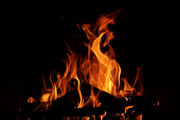mNo edit summary Tag: sourceedit |
(info) Tag: Visual edit |
||
| (29 intermediate revisions by 14 users not shown) | |||
| Line 1: | Line 1: | ||
| + | [[File:Fires.jpg|thumb]] |
||
| − | {{Backto}} |
||
| ⚫ | '''Pyrophobia''' |
||
| ⚫ | |||
| ⚫ | '''Pyrophobia''' (from Greek ''pyro'', "fire"), is the fear of fire. This phobia is ancient and primordial, perhaps since mankind's discovery of fire. The most common cause of pyrophobia is that fire poses a potential danger, such as house fire, wildfire, and getting caught on fire. Some people who are intensely pyrophobic cannot even get close to or tolerate even a small controlled fire, such as fireplace, bonfire or lit candle. In many cases a bad childhood experience with fire may have triggered the condition. |
||
| ⚫ | |||
| + | |||
| ⚫ | |||
| + | |||
| ⚫ | Exposure therapy is the most common way to treat pyrophobia. This method involves showing patient fire in order of increasing size, from lit cigarette up to stove or grill flame. Another method of treatment is talk therapy, in which a patient tells a therapist about the cause of this fear, and then calming down the patient by not be afraid of controlled fire. People can also relieve pyrophobia by interacting with other pyrophobes to share their experiences that caused fear. Alternatively, pyrophobia can be treated using hypnosis. Medication can also be used to treat pyrophobic people, although since it has side effects, the method is not highly recommended. |
||
| + | |||
| + | == See also == |
||
| + | |||
| + | * [[Agripyrophobia]] – fear of wildfires |
||
| − | ==External links== |
||
| − | *[http://phobias.about.com/od/phobiaslist/f/What-Is-The-Fear-Of-Fire.htm Pyrophobia Is the Fear of Fire] about.com |
||
[[Category:Phobias]] |
[[Category:Phobias]] |
||
Revision as of 01:37, 22 July 2021

Pyrophobia (from Greek pyro, "fire"), is the fear of fire. This phobia is ancient and primordial, perhaps since mankind's discovery of fire. The most common cause of pyrophobia is that fire poses a potential danger, such as house fire, wildfire, and getting caught on fire. Some people who are intensely pyrophobic cannot even get close to or tolerate even a small controlled fire, such as fireplace, bonfire or lit candle. In many cases a bad childhood experience with fire may have triggered the condition.
If a pyrophobe sees fire, the person may sweat and suffer dizziness or upset stomach. A person with severe pyrophobia who sees fire may panic and experience fast breathing, irregular heartbeat, shortness of breath, nausea, dry mouth, dread, feeling trapped, and may tremble or faint.
Exposure therapy is the most common way to treat pyrophobia. This method involves showing patient fire in order of increasing size, from lit cigarette up to stove or grill flame. Another method of treatment is talk therapy, in which a patient tells a therapist about the cause of this fear, and then calming down the patient by not be afraid of controlled fire. People can also relieve pyrophobia by interacting with other pyrophobes to share their experiences that caused fear. Alternatively, pyrophobia can be treated using hypnosis. Medication can also be used to treat pyrophobic people, although since it has side effects, the method is not highly recommended.
See also
- Agripyrophobia – fear of wildfires